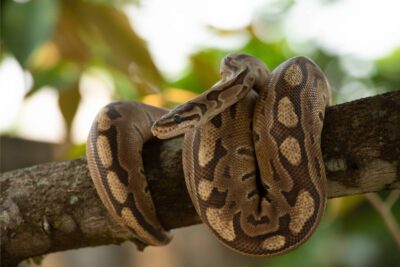Can ball pythons swim? It’s a question that often arises among reptile enthusiasts and prospective pet owners alike. As captivating creatures known for their docile nature and unique patterns, ball pythons are a popular choice in the world of exotic pets.
However, understanding their behavior and capabilities is essential for their proper care and well-being. In this article, we delve into the intriguing inquiry of whether these serpents possess the ability to navigate through water. Let’s unravel the truth behind this fascinating aspect of ball python biology.
Can ball pythons swim?

Ball pythons are not natural swimmers, and they typically avoid water if possible. While they are capable of moving in water for short distances if necessary, they are not proficient swimmers like aquatic animals.
In their natural habitat, ball pythons are terrestrial creatures found in the grasslands and forests of West and Central Africa, where they spend most of their time on land.
However, if a ball python finds itself in water, it can use its muscular body to propel itself through the water for a short period. It’s important to note that prolonged exposure to water can be stressful for ball pythons and may lead to health issues, so it’s best to avoid submerging them in water unnecessarily.
Respiratory system of ball pythons and its adaptation to aquatic environments
Ball pythons, like other snakes, have a respiratory system adapted for breathing air. They rely on lungs for respiration, unlike aquatic animals that often have gills for extracting oxygen from water.
The respiratory system of a ball python consists of:
- Lungs: Ball pythons have a pair of lungs, which are elongated organs situated within their body cavity. The lungs expand and contract to draw in air through the nostrils.
- Nostrils: Ball pythons have two nostrils located on either side of their head, which they use to detect scents and breathe in air.
- Trachea: The trachea, or windpipe, is a tube that connects the nostrils to the lungs. Air passes through the trachea on its way to and from the lungs.
- Glottis: The glottis is a specialized structure at the entrance to the trachea. It can close to prevent water from entering the respiratory system when the snake is submerged.
While ball pythons can tolerate brief periods of submersion and may use their muscles to move through water for short distances, they are not adapted for prolonged aquatic life. Their respiratory system is not designed for extracting oxygen from water like that of fish or other aquatic animals.
Therefore, extended exposure to water can be stressful for ball pythons and may lead to respiratory problems and other health issues. It’s essential to provide appropriate environmental conditions for ball pythons, including a dry habitat with access to fresh air.
Swimming Behavior of Ball Pythons
While ball pythons are not aquatic creatures and generally avoid water, they can exhibit swimming behavior if necessary. In the wild, they may encounter bodies of water such as streams, ponds, or flooded areas and might swim to cross them or escape threats. However, their swimming ability is not as proficient as that of animals specifically adapted to aquatic life.
When ball pythons swim, they use a combination of muscular movement and buoyancy to propel themselves through the water. Their bodies are relatively streamlined, which helps them move more efficiently. They may undulate their bodies laterally, similar to the motion used for crawling on land, to push themselves forward in the water.
It’s important to note that while ball pythons can swim when needed, they are not built for extended periods in water. Prolonged submersion can be stressful for them and may lead to health issues, including respiratory problems.
Therefore, it’s best to provide them with a dry habitat in captivity and only allow them to swim briefly if necessary, such as during cleaning or when providing a shallow water dish for drinking or soaking.
Common swimming patterns observed in captive ball pythons


